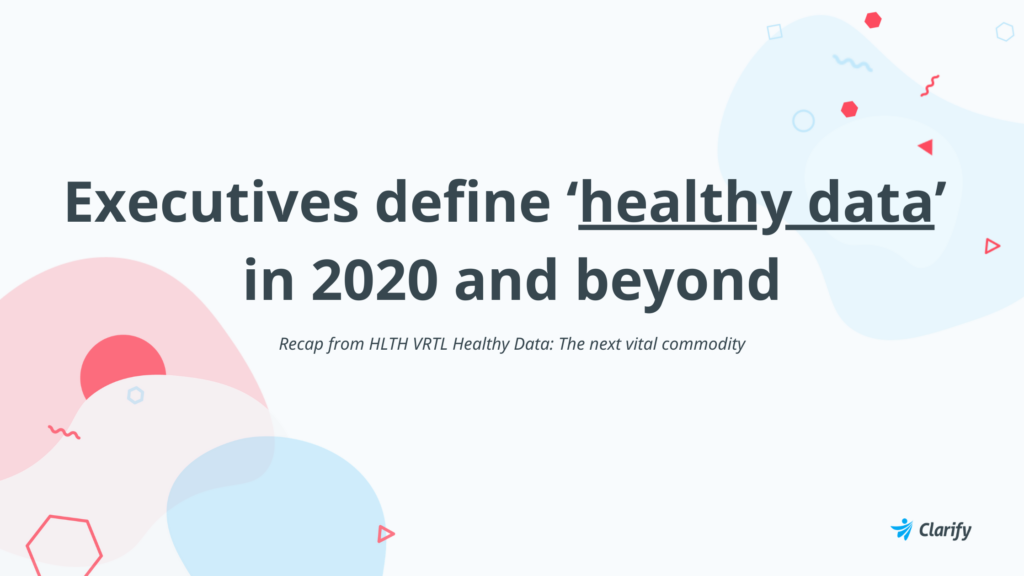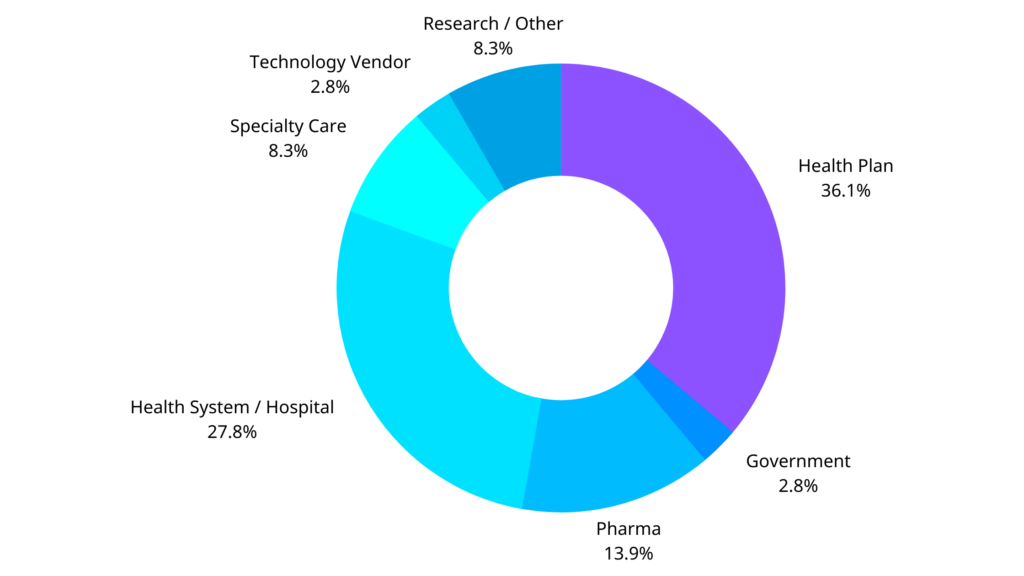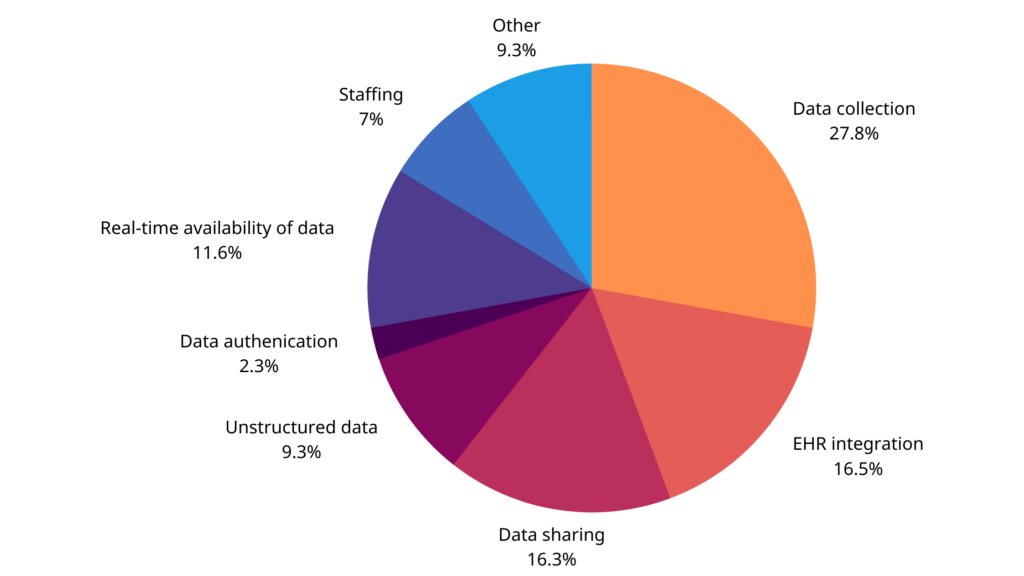
Insights for Providers
Apr 10, 2024
Insights for Payers | November 19, 2020

Executives from across the industry joined conversations on the topic of “healthy data” at this year’s HLTH VRTL conference. Leaders from Horizon BlueCross BlueShield of New Jersey, Abbvie, Kaweah Delta, and Clarify Health hosted a series of table talk discussions to unpack the concept of healthy data and to understand how leading organizations from across the healthcare landscape plan to implement a healthy data strategy. There was a wide range of participants from payer, provider, life sciences, consulting, and technology companies, all with varying levels of expertise in dealing with health-related data. Here is a recap of the poignant points and insights.

Figure 1: Industry representation during Healthy Data Table Talks
Ten years ago, the health of a dataset was a measure of quality – is it complete? Is it reliable? But as the industry has matured, it assumes quality, completeness, and reliability, and has moved on to the next frontier in healthy data, which demands interoperability, longitudinality, and integration at all levels of the business. As new types of technology – especially the technology to link disparate data sets – have become available, we’re expecting more of our data than ever before.
Healthy data is usable data upon which you can unlock insights and drive real value.
From our Table Talk conversations, we found the challenges organizations face in 2020 are the same ones the industry has faced for years. For organizations early in their data analytics journey, there are many practical challenges to overcome when it comes to data integration and analysis. Data collecting, cleaning, organizing, and standardizing were frequently brought up as significant barriers to running effective analytics.

Figure: 2016 data integration and analytics pain points in healthcare
Source: January 2016 Data Analytics survey by the Healthcare Intelligence Network.
The more practiced organizations cited hurdles with leadership, trust in the data, and technology constraints. Advanced organizations shared difficulties in building a data strategy that would leave room to scale and continually drive impact.
In addition to challenges, participants also shared strategies for enhancing in-house capabilities, including pursuing and acquiring data, partnering with vendors, and making a case for investment in data analytics.
Participants shared how they are taking steps to build a healthy data strategy. The most common themes were around centralizing data, diversifying data sources, gaining a longitudinal view of an individual patient, and using data insights to enable value-based care.
The question is: how do we turn this data into insights we can act on?
For every participant, what healthy data ultimately boiled down to was, “can I make a better, more informed decision with these data points than I could before?” To that end, we heard a number of great examples of organizations taking steps to make their data analytics more actionable. For instance,
While not every organization has an advanced analytics engine running today, all participants could articulate a vision for how the building blocks they are investing in will enable healthy data strategies in the future. The COVID-19 pandemic has highlighted the fact that we are asking questions of our data that we wouldn’t have thought of at the beginning of the year. We are starting to realize that our data strategy from three years ago is limiting our ability to effectively adapt to the situation today.
How well suited is your data to answer business questions that haven’t even popped up yet?
Healthcare has an opportunity to learn from other industries like online retailers, streaming services, and search engines to improve both the personalized experience of care by patients and the individualized, precise delivery of care. The common thread across use cases from other industries is data that’s been brought together and centered around a single entity. As one advanced health plan put it during our talks, “we’re in the business of n=1.”
Healthy data is the navigation system to better decisions for patients, and the more specific, in-depth, and timely our insights become, the better we can care for our populations. One international participant painted a picture of how their academic medical center has an advanced data and analytics program that takes in data from across the spectrum to keep their patient populations healthy, improve outcomes and experiences, and make the hospital more financially sustainable. The center uses outcome data from the hospital and the national database, population data, socioeconomic data, patient and consumer-generated data, and electronic medical records (EMRs) to train predictive models. They are making advances to incorporate new types of data into their analyses, including mental health services, how students are performing in school, prescription, and genomic data.
Healthy data strategies can also lead to better data sharing and communication across payers, providers, and life sciences organizations. One executive from a health plan is betting on machine learning and AI to enable faster decision making and bi-directional conversations between payers and providers. Noting there are still barriers to cross-industry data sharing, one participant said, “when we all come together and try to take these data elements to expand the picture, it’s critical that we are all speaking the same language.” Having a common data source spanning payers, providers, and life sciences can enable more collaboration and advances in outcomes-based care.
Through a combination of data availability, robust de-identification techniques, accurate linkage methodologies, and powerful computing technology that allows us to take raw data and turn it into something that’s observable, assessable, scalable, and upon which analysis can be run, we built the industry’s first healthy dataset. We believe this is the most powerful asset available on the market to augment any provider, payer, or life sciences organization’s data strategy to unlock actionable insights and drive value.